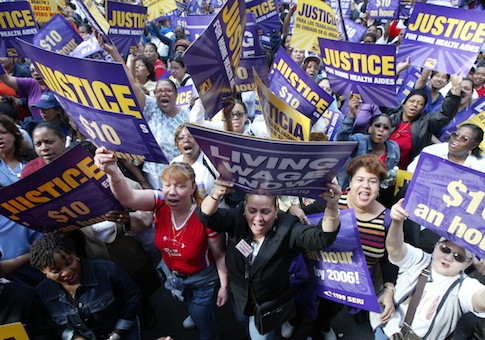Labor giant SEIU spent more than $100 million on union overhead and political activities in 2014, according to federal labor filings released Tuesday evening.
The union collected about $320 million from its 1.8 million members, who are primarily government employees and health care workers. For every $3 that a union member contributed to its coffers, $1 went to functions outside of membership services.
The union spent about $55 million paying union administrators and covering overhead costs, including more than $276,000 to president Mary Kay Henry.
Michael Saltsman, research director at the Employment Policies Institute, said that the filings highlight a disconnect between the lives of union leaders and the populist rhetoric they adopt publicly—not to mention the interests of SEIU members.
"All that money is coming out of the paychecks of janitors and other members who think they’re paying for someone to represent their best interests," Saltsman said.
"It defies credulity to sit here and say you have the best interest of the working class in mind when you’re using that money to make sure your own staff and administration are extremely well compensated."
Union staffers weren’t the only ones to profit from membership dues. Lobbyists and political campaigns benefited from SEIU dollars during the 2014 elections.
The union spent about $48 million on "political activities and lobbying" on the year. It was the seventh biggest spender at the federal level, according to the Center for Responsive Politics, with all the money going to support Democratic candidates and associated liberal campaign apparatus.
Saltsman said such spending is significant given the public sector workers that SEIU represents. The massive contributions derived from membership dues build key allies among elected officials who then negotiate contracts and benefits with the union.
"It’s a vicious cycle," Saltsman said. "In a lot of cases, the government collects dues from employees, puts it in the hands of the union, which turns around and spends it on politicians and lobbying for policies. That strengthens their clout even further."
The union dedicated resources to helping stir up public protests against fast food franchises. It pumped at least $14 million into the Fight for $15 movement, which seeks to dramatically increase wages for fast food workers. The money was disbursed into a front group called Fast Food Forward as well as regional organizing committees that staged protests outside of restaurants like McDonald’s over the past few years. Those contributions do not include the $1.3 million SEIU gave to Democratic PR powerhouse Berlin Rosen to promote its wage increase agenda.
Ashley Pratte, a spokeswoman for labor watchdog Worker Center Watch, said that the money has proved a useful investment, as media outlets covered the AstroTurf campaigns as legitimate workers’ movements. The union has also managed to operate at the very edges of labor law—even though these front groups act as union subsidiaries, the National Labor Relations Board has often failed to classify them as such.
"The SEIU continues to not only deceive the public but also workers by funneling huge sums of money into union front groups," Pratte said. "Unfortunately, the regulatory agency tasked with monitoring these activities—the NRLB—is a known facilitator of the SEIU's stealth organizing campaign.".
The NLRB’s relationship with the SEIU has come under scrutiny from critics and even the judicial system.
The agency rolled out controversial new regulations dramatically altering the union election process at SEIU Local 32BJ’s Manhattan headquarters in March. A federal judge in Pennsylvania blasted the agency’s regional investigators for acting as an SEIU subsidiary, rather than an unbiased arbiter, in September 2014.
"The scope and nature of the requests, coupled with the NLRB’s efforts to obtain said documents for and on behalf of the SEIU, arguably moves the NLRB from its investigatory function and enforcer of labor law to serving as the litigation arm of the Union, and a co-participant in the ongoing organization effort of the Union," Judge Arthur Schwab said in a ruling.
The SEIU has also steered resources toward liberal think tanks, which have served as clearinghouses for studies and legal theories supporting union positions.
It sent $150,000 to the Economic Policy Institute and $195,510 to the National Employment Law Project, which have also received largesse from the Democracy Alliance.
NELP played a vital role in the fast food organizing movement. In May 2014, NELP invited Department of Labor regulators to speak at a conference aimed at expediting the path to unionization. SEIU organizer Kendall Fells also spoke at the conference, joking about the arbitrary demand of $15 and disrupting businesses that do not cooperate.
"[A franchise] profit margin is so small that they’re kind of forced to make an economic decision," Fells said. "These franchise owners are being, you know, most of them are being squeezed. They’re not making that much money."
America’s 780,000 franchise businesses would suffer if the SEIU got its way, according to Matthew Haller, spokesman for the International Franchising Association.
"The unfortunate reality of this massive spending campaign is if the unions get their way, small business owners get squeezed out, workers will lose their jobs and the only people who will benefit are the union leaders and the politicians beholden to them," Haller said.
The SEIU did not return Washington Free Beacon requests for comment.
